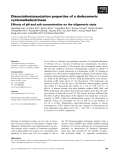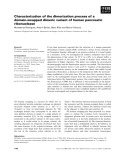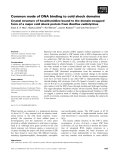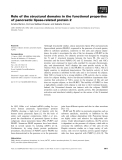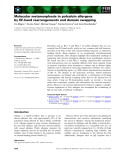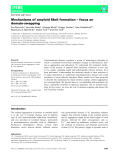
Domain swapping
-
As an effort to elucidate the quaternary structure of cyclomaltodextrinase I-5 (CDase I-5) as a function of pH and salt concentration, the dissoci-ation/association processes of the enzyme were investigated under various pH and salt conditions. Previous crystallographic analysis of CDase I-5 indicated that it existed exclusively as a dodecamer at pH 7.0, forming an assembly of six 3D domain-swapped dimeric subunits.
 13p
13p  dell39
dell39
 27-03-2013
27-03-2013
 30
30
 4
4
 Download
Download
-
It has been previously reported that the structure of a human pancreatic ribonuclease variant, namely PM8, constitutes a dimer by the exchange of an N-terminal domain, although in an aqueous solution it is found mainly as a monomer. First, we investigated the solution conditions that favour the dimerization of this variant.
 11p
11p  inspiron33
inspiron33
 26-03-2013
26-03-2013
 54
54
 5
5
 Download
Download
-
Bacterial cold shock proteins (CSPs) regulate cellular adaptation to cold stress. Functions ascribed to CSP include roles as RNA chaperones and in transcription antitermination. We present the crystal structure of the Bacil-lus caldolyticus CSP (Bc-Csp) in complex with hexathymidine (dT6)ata resolution of 1.29 A ˚ .
 15p
15p  galaxyss3
galaxyss3
 21-03-2013
21-03-2013
 40
40
 5
5
 Download
Download
-
Although structurally similar, classic pancreatic lipase (PL) and pancreatic lipase-related protein (PLRP)2, expressed in the pancreas of several species, differ in substrate specificity, sensitivity to bile salts and colipase depen-dence. In order to investigate the role of the two domains of PLRP2 in the function of the protein, two chimeric proteins were designed by swapping the N and C structural domains between the horse PL (Nc and Cc domains) and the horse PLRP2 (N2 and C2 domains).
 13p
13p  media19
media19
 05-03-2013
05-03-2013
 49
49
 3
3
 Download
Download
-
Polcalcins such as Bet v 4 and Phl p 7 are pollen allergens that are con-structed from EF-hand motifs, which are very common and well character-ized helix–loop–helix motifs with calcium-binding functions, as elementary building blocks. Being members of an exceptionally well-characterized protein superfamily, these allergens highlight the fundamental challenge in explaining what features distinguish allergens from nonallergenic proteins.
 13p
13p  mobifone23
mobifone23
 21-01-2013
21-01-2013
 35
35
 3
3
 Download
Download
-
The bacterial twin-arginine translocation (Tat) system is a protein targeting pathway dedicated to the transport of folded proteins across the cytoplas-mic membrane. Proteins transported on the Tat pathway are synthesised as precursors with N-terminal signal peptides containing a conserved amino acid motif.
 15p
15p  mobifone23
mobifone23
 18-01-2013
18-01-2013
 38
38
 4
4
 Download
Download
-
Conformational diseases constitute a group of heterologous disorders in which a constituent host protein undergoes changes in conformation, lead-ing to aggregation and deposition. To understand the molecular mecha-nisms of the process of amyloid fibril formation, numerousin vitro and in vivo studies, including model and pathologically relevant proteins, have been performed.
 20p
20p  cosis54
cosis54
 05-01-2013
05-01-2013
 35
35
 2
2
 Download
Download
CHỦ ĐỀ BẠN MUỐN TÌM









